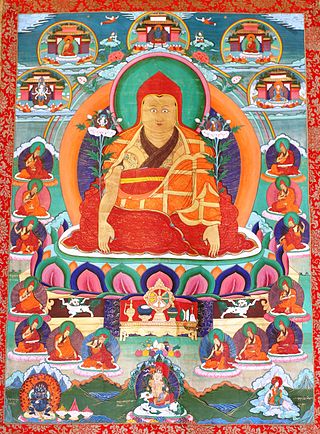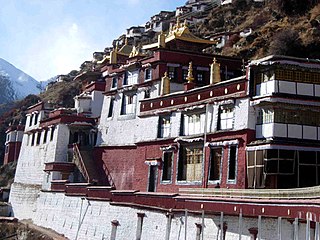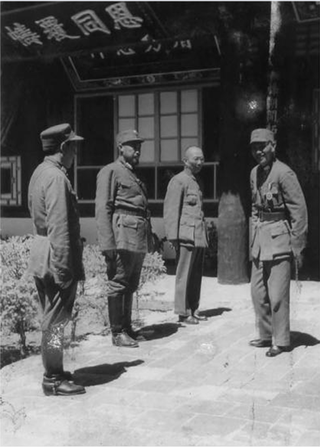Related Research Articles

The Gelug is the newest of the four major schools of Tibetan Buddhism. It was founded by Je Tsongkhapa (1357–1419), a Tibetan philosopher, tantric yogi and lama and further expanded and developed by his disciples.

The Kagyu school, also transliterated as Kagyü, or Kagyud, which translates to "Oral Lineage" or "Whispered Transmission" school, is one of the main schools of Tibetan Buddhism. The Kagyu lineages trace themselves back to the 11th century Indian Mahasiddhas Naropa, Maitripa and the yogini Niguma, via their student Marpa Lotsawa (1012–1097), who brought their teachings to Tibet. Marpa's student Milarepa was also an influential poet and teacher.

The Jonang is a school of Indo-Tibetan Buddhism. Its origins in Tibet can be traced to the early 12th century master Yumo Mikyo Dorje. It became widely known through the work of the popular 14th century figure Dolpopa Sherab Gyaltsen. The Jonang school’s main practice is the Kālacakra tantra, and they are widely known for their defense of the philosophy known as shentong.

Ngawang Lobsang Gyatso was the 5th Dalai Lama and the first Dalai Lama to wield effective temporal and spiritual power over all Tibet. He is often referred to simply as the Great Fifth, being a key religious and temporal leader of Tibetan Buddhism and Tibet. Gyatso is credited with unifying all Tibet under the Ganden Phodrang after a Mongol military intervention which ended a protracted era of civil wars. As an independent head of state, he established relations with the Qing empire and other regional countries and also met early European explorers. Gyatso also wrote 24 volumes' worth of scholarly and religious works on a wide range of subjects.

Lhünzhub County is a county in Lhasa towards the north-east of the main center of Chengguan, Tibet, China. It covers an area of 4,512 km2 (1,742 sq mi) and as of 2000 had a population of 50,895 people, almost all classified as rural. The southern portion, the Pengbo River Valley, contains fertile arable land, while the colder and more mountainous northern portion primarily supports grazing. The county has many monasteries, including the Reting Monastery.

Dölpopa Shérap Gyeltsen (1292–1361), known simply as Dölpopa, was a Tibetan Buddhist master. Known as "The Buddha from Dölpo," a region in modern Nepal, he was the principal exponent of the shentong teachings, and an influential member of the Jonang tradition of Tibetan Buddhism.

The Palcho Monastery or Pelkor Chode Monastery or Shekar Gyantse is the main monastery in the Nyangchu river valley in Gyantse, Gyantse County, Shigatse Prefecture, Tibet Autonomous Region. The monastery precinct is a complex of structures which, apart from the Tsuklakhang Monastery, also includes its Kumbum, believed to be the largest such structure in Tibet, that is most notable for its 108 chapels in its several floors and the old Dzong or fort.

Drigung Thil Monastery is a monastery in Maizhokunggar County, Lhasa, Tibet founded in 1179. Traditionally it has been the main seat of the Drikung Kagyu tradition of Tibetan Buddhism. In its early years the monastery played an important role in both religion and politics, but it was destroyed in 1290 by Mongol troops under the direction of a rival sect. The monastery was rebuilt and regained some of its former strength, but was primarily a center of meditative studies. The monastery was destroyed after 1959, but has since been partly rebuilt. As of 2015 there were about 250 resident monks.

Gonggar County, also Gongkar, is a county of Shannan in the Tibet Autonomous Region, China, it's one of the 12 counties of the prefecture. It has under its jurisdiction five towns, four townships, and contains notable landmarks such as the Gonggar Choide Monastery, the Zhug Dêqên Qoikor Monastery, Gangdoi Town, the Gonggar Dzong at Xoi, the Lhasa Gonggar Airport at Gyazhugling, the Tubdain Ramai Monastery and the county seat of Gyixung.

Lamaling Monastery, also known as Zangdrok Pelri Monastery and Burqug Lamaling (布久喇嘛林寺), is a Buddhist monastery located near the village of Jianqie, Burqug Township, Bayi District, in Tibet, on a small hill 1.5 km south of Buchu Monastery. The monastery belongs to the Nyingmapa sect, translated as the ‘Ancient Ones’; their lineages go back to the first infusion of Buddhism from India to Tibet in the 7th century CE. The Nyingma sect incorporated many of the traditions of the native Tibetan Bon religion, which respects nature and local nature spirits.

Katok Tsewang Norbu was a teacher of the Nyingma school of Tibetan Buddhism who notably championed the shentong or "empty of other" view first popularised by the Jonang school as well as examining the Chan Buddhist teachings of Hashang Mahayana, known as Moheyan. Despite the shentong view being banned as heretical, he successfully taught and cultivated its teachings as a legitimate view among the Nyingmapa.
Jianmoda Monastery is a Tibetan Buddhist monastery of the Jonang sect in the Golog Tibetan Autonomous Prefecture of Qinghai province, China. It is located on the slope of the Yamrixumo Mountain in the Jianmo River Valley, in Sogrima Township, 87 km west of Chorzhi County's Zhiqensomdor Township. The Zamda River is located to the left of the monastery and the Jianmo River is located in front.
Langboin Monastery or Dor'oxoizhuling is a Tibetan Buddhist monastery of the Jonang sect in the Golog Tibetan Autonomous Prefecture of Qinghai province, China. It is located 10 km west of Baima County in Langboin village, in Moba Township.
Zhaxiqoilang Monastery is a Tibetan Buddhist monastery of the Jonang sect in the Golog Tibetan Autonomous Prefecture of Qinghai province, China. It is located on the Xike Qu River in east Gande County. The monastery has a monk population of 64 with one adobe sutra hall.

Dzongsar Monastery is a Buddhist monastery in Dêgê County in the Garzê Tibetan Autonomous Prefecture of Sichuan, China, southeast of the town of Derge and east of Palpung Monastery. Historically it lay in the Kham region of Tibet. It was founded in 746, destroyed in 1958, and rebuilt in 1983.

The Ma clique fought a series of military campaigns between 1917 and 1949 against unconquered Amchok and Ngolok (Golok) tribal Tibetan areas of Qinghai (Amdo), undertaken by two Hui commanders, Gen. Ma Qi and Gen. Ma Bufang, on behalf of the Beiyang and Kuomintang governments of the Republic of China. The campaigns lasted between 1917 and 1949. The conflict was spurred by multiple factors, notably for economic and socio-political reasons rather than by any racial or religious enmity.

As of May 2022, 160 monks, nuns, and ordinary people have self-immolated in Tibet since 27 February 2009, when Tapey, a young monk from Kirti Monastery, set himself on fire in the marketplace in Ngawa City, Ngawa County, Sichuan. According to the International Campaign for Tibet (ICT), "Chinese police have beaten, shot, isolated, and disappeared self-immolators who survived."

Although there were many householder-yogis in Tibet, monasticism was the foundation of Buddhism in Tibet. There were over 6,000 monasteries in Tibet. However, nearly all of these were ransacked and destroyed by Red Guards during the Cultural Revolution. Most of the major monasteries have been at least partially re-established, while many others remain in ruins.
Lenggu Monastery, also transliterated as Rengo Monastery or Nego Monastery, is a Tibetan Buddhist monastery at the foot of Ge'nyen Mountain in Sichuan, China. The monastery was formerly known as Kambo Dansar and was the first monastery built by the first Kamapa Duisung Chenpa in 1164. The 7th Kamapa Quzha Qiangcuo enlarged it. At its peak, over 2000 monks studied at the monastery. Today, Lengu is administered as part of Zhamla Township in Litang County, Garze Prefecture, Sichuan.

Khentrul Jamphel Lodrö Rinpoché is a Tibetan Buddhist Rimé Master. Shar Khentrul Jamphel Lodro Rinpoché teaches predominantly the extensive Kalachakra system according to the Jonang tradition of Tibetan Buddhism. He is the founder and spiritual director of the Tibetan Buddhist Rimé Institute or Tong Zuk Dechen Ling in the Tibetan language. He translated the Jonang Kalachakra practice texts, with instructions, into English and Chinese.
References
- ↑ Monasteries of the Jonang Sect in Golog, Tibetinfor.com. archived here